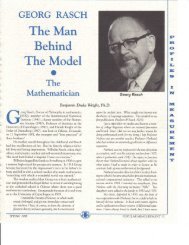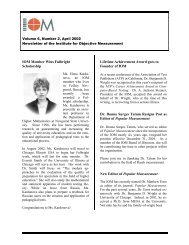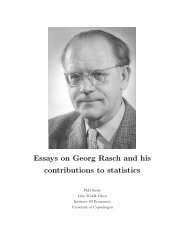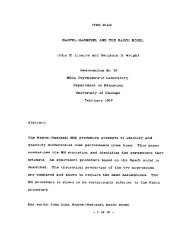Memo # 1964-2 PDF - Verio
Memo # 1964-2 PDF - Verio
Memo # 1964-2 PDF - Verio
You also want an ePaper? Increase the reach of your titles
YUMPU automatically turns print PDFs into web optimized ePapers that Google loves.
- 21 -<br />
It is suggested that comparisons carried out under such<br />
circumstances will be designated as "specifically objective".<br />
And the same term would seem appropriate for statements about<br />
the model structure which are independent of all of the parameters<br />
specified in the model, the unknown values of them being,<br />
in fact, irrelevant for the structure of the model.<br />
Of course, specific objectivity is no guarantee against the<br />
subjectivity of the statistician when he choses his fiducial<br />
limits or when he judges about which kind of deviations from<br />
the model he will look for. Neither does it save the statistician<br />
from the risk of being offered data marred by the subjective<br />
attitude of the psychologist during his observations.<br />
Altogether, when introducing the concept of specific objectivity<br />
I am not entering upon a general philopophical debate on the •<br />
meaning and the use of objectivity at large. At present the<br />
term is strictly limited to observational situations that can<br />
be covered by the stimulus - subject-response scheme, to be<br />
described in term of a prrNlyll, i1t3tio ,.o0(:1 c7Jhic<br />
parameters for stimuli and for subjects. And the independence<br />
of unwarranted parameters, entering into the characterization<br />
of specific objectivity, pertains only to such parameters as<br />
are specified in the model.<br />
What has been demonstrated in details in the case of two<br />
response categories and indicated for a finite number of<br />
categories then is that the specific objectivity in all three<br />
directions can be attained in so far as the type of model<br />
defined by (7.1), (7.2) and the independence holds.<br />
Recently it has been shown that - but for unimportant mathematical<br />
restrictions - the inverse statement is also true:<br />
If a set of observational situations can at all be described<br />
by a probabilistic model (7.1), including the independence,<br />
then the multiplicative rule (7.2) is also necessary for<br />
obtaining specific objectivity as regards both eets of<br />
parameters and the model structure as well.<br />
In particular, if only two responses are available then the<br />
observations must conform to the simple model (7.6) (or<br />
equivalently (3.3)) if it be possible to maintain specific<br />
objectivity in statements about subjects, stimuli and model.<br />
9. Reduction of parameters.<br />
The general model allots m parameters to a subject and equally<br />
many to astimulus i and even if, by an argument similar to (7.4)<br />
through (7.7), the number may be reduced to m-1 it easily becomes<br />
unduly large.<br />
As a case in point we may think of a number of texts, each of Zoo<br />
words, to be used in testing for proficiency in reading aloud. With<br />
number of errors as response categories each child as well as each<br />
text should, according to the model (7.2) and (7.3), be characterized









